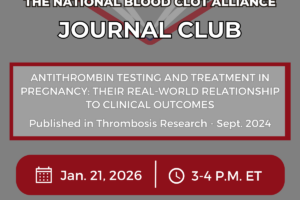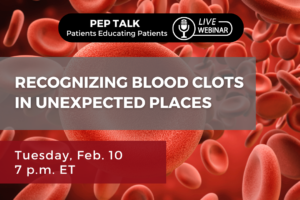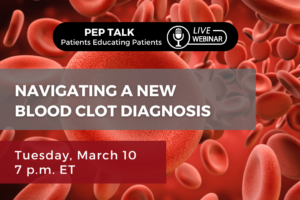March is Blood Clot Awareness Month, an observance conceived in a bipartisan manner through the sponsorship efforts of Congresswomaen Lois Capps (D-CA) and Cathy McMorris Rodgers (R-WA), who experienced the tragedy of blood clots through loved ones. Rep. Capps’ husband, former Rep. Walter Capps died prematurely of a PE in 2006 as did Rep. McMorris Rodgers’ dear friend and mentor, former Rep. Jennifer Dunn, who suddenly perished from a PE in 2007.
Blood clots do not discriminate by age, gender, ethnicity or race. They can affect anyone — from infants and young children to teens, young moms and dads, those in middle age or senior citizens. Across the country and around the world, elite athletes, public servants, musicians, doctors, nurses, business associates and many wonderful people from all walks of life are affected. A blood clot is diagnosed once every minute.
And, sadly – once every six minutes someone dies from a blood clot.
Blood clots are the #1 killer of new mothers in childbirth and affect women across the life span from those on birth control to those receiving post-menopausal hormone replacement therapy. They affect people being treated for cancer and other chronic diseases and people undergoing joint replacement surgery and other surgical procedures. They can be triggered by a genetic predisposition or by lengthy immobility. They can affect the more than 5 million Americans who suffer Atrial Fibrillation that places them at heightened risk of a clot in the heart that can travel to the brain and cause stroke and death. With many of these risks for life-threatening blood clots increasing as our population ages, so too will the public health challenge.
Fortunately, many blood clots can be prevented and, in those that occur, poor outcomes (death, morbidity, and recurrence) may be preventable with early and accurate diagnosis and management. One of the major challenges for preventing VTE is the ability to ensure the use of appropriate prevention measures. For example, patients who were recently hospitalized or have had surgery have an increased risk of developing VTEs that are highly preventable.
Appropriate prevention among these patients can result in a significant reduction in VTE occurrence, healthcare burden, economic impact and death. Today, blood clots are the leading cause of unnecessary hospital readmissions that have been estimated to cost more than $10 billion of the total $16 billion expended in the treatment of blood clots at hospitals nationwide. Eliminating such waste and ensuring improved health care outcomes post-surgery is vital not only to saving lives but achieving huge health care cost savings.







